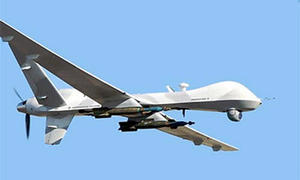DronesDrones must be used wisely to help advance U.S. interests
A new report examines three key issue sets in the unmanned aerial vehicle (UAV) debate: defense utility, national security, and economics; ethics and law; and export controls and regulatory challenges. The report concludes that UAV technologies are here to stay. Used recklessly, UAVs can endanger U.S. interests and diminish regional and global stability. Used wisely, they can help advance U.S. national security interests in the midst of a more robust global commitment to the rule of law.

There are far fewer armed UAVs than popular knowledge believes // Source: af.mi
The Stimson Center’s Task Force on U.S. Drone Policy issued a report last week examining three key issue sets in the unmanned aerial vehicle (UAV) debate: defense utility, national security, and economics; ethics and law; and export controls and regulatory challenges. The analysis identified misconceptions about drones, areas of concern, and also recommended a few ways to advance the drone debate.
The most common drone misconceptions is the belief that most UAVs are weaponized when, in reality, less than 1 percent of the Pentagon’s 8,000 drones carry operational weapons at any given time. The majority of U.S. drone missions has been for intelligence, surveillance, and reconnaissance (ISR) purposes.
UAVs are often thought to be cheaper alternatives to manned aircrafts, but some UAVs “carry more sensors than their manned counterparts,” which may translate to higher cost for personnel to monitor and process data feeds that do not exist on manned aircrafts.
The Stimson report notes that at times, the higher cost of manned aircrafts reflects greater capability. A manned F-16 fighter jet may have higher costs because it consumes fuel more quickly than an MQ-1 Predator drone, but the F-16’s greater speed gives it air-to-air combat abilities that current drones lack.
Areas of concern include the advances in drone technologies. U.S. policymakers will be faced with questions on robotic autonomy in wartime theaters. The Homeland Security News Wire reported in May that delegates from several international organizations and governments around the world are debating under the United Nations umbrella, how to deal with “lethal autonomous weapons systems,” or killer robots, in times of war. Military analysts anticipate the increasing use of drones as instruments of war as UAV technology becomes easier to employ, but export controls will have to be strictly defined without undermining innovation. TheCouncil of Foreign Relations warns that the use of American drones in non-declared combat areas defies international law and sets a precedent that other nations might one day follow (and not to our benefit).
To advance the debate on drones, the United States should continue the transfer of general UAV responsibility from the CIA to the military. Should CIA involvement in drone missions prove necessary, the reports recommends that lethal drone strikes should be arbitrated through a single integrated system. To ease concerns about transparency, completed drone strikes should be acknowledged and disclosed. “A broad, secret, multi-year UAV strike program runs contrary to American values and democratic rule of law,” the report states.
The Stimson Center 10-member task force on U.S. drone policy affirms that UAV technologies are here to stay. Used recklessly, they can endanger U.S. interests and diminish regional and global stability. Used wisely, they can help advance U.S. national security interests in the midst of a more robust global commitment to the rule of law.
